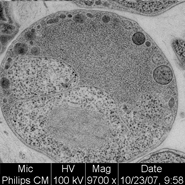Posted 06 December 2010
Sewage water bacteria helps fill ‘missing link’ in early evolution
A common group of bacteria found in acid bogs and sewage treatment plants has provided scientists with evidence of a ‘missing link’ in one of the most important steps in the evolution of life on earth - the emergence of cells with a nucleus containing DNA (eukaryotic cells).
For billions of years, bacteria (single celled organisms without a nucleus) were the only cellular life form on earth. Then, about 1.6 – 2.1 billion years ago, eukaryotic cells emerged. These cells (with a nucleus) heralded the evolution of multi-cellular life on earth including: plants, insects, animals and humans.
Pictured far right: A Planctomycete: a member of the PVC [Planctomycetes, Verrucomicrobiae, Chlamydiae] group of bacteria
Until now scientists have been unable to identify an ‘ancestral cell’ linking the early prokaryotes with the later eukaryotes, so fusion theory - where two cells merge to form a new cell – is often put forward to explain the appearance of these new cell types.
But new findings by scientists from University College Dublin and the European Molecular Biology Laboratory in Heidelberg, Germany, published in the journal Science (26 November 2010), have put paid to the fusion theory explanation, and suggest that an intermediate or ‘missing link’ cell did exist all those billions of years ago.
“Our discovery means that the appearance of eukaryotic cells on earth can be explained by Darwinian evolution over billions of years rather than a ‘big bang’ fusion theory,” says cell biologist Dr Emmanuel Reynaud, from the UCD School of Biology and Environmental Science, University College Dublin, one of the co-authors of the scientific paper.
“Our analysis shows that PVC [Planctomycetes, Verrucomicrobiae, Chlamydiae] bacteria, members of which are commonly found in today’s sewage treatment plants or acid bogs, represent an intermediate type of cell structure. They are slightly bigger than other known bacteria, and they also divide more slowly.”
“The structure of PVC suggests that it is an ancestor of a ‘missing link’ cell which connected prokaryotic to eukaryotic cells along an evolutionary path all those billions of years ago,” says Dr Damien P Devos, European Molecular Biology Laboratory, Heidelberg, Germany, the other scientist involved in the findings.
Scientific Journal Reference
“Intermediate steps” – Published in Science (26 Nov 2010)
Damien P Devos, European Molecular Biology Labratory, Heidelberg, Germany; and Emmanuel G Reynaud, UCD School of Biology and Environmental Science, University College Dublin, Ireland.
Cell theory
Scientists once believed that living things could spontaneously generate from non-living matter - abiogenesis. But modern science lays all that to rest. Cell theory outlines the basic rules that apply to the smallest unit of life:
- All organisms are composed of one or more cells
- Cells are the basic unit of structure and function in organisms
- All cells come only from other cells
Prokaryotic cells
For billions of years, prokaryotic cells were the only life form on earth. They are primarily distinguished by the fact that they lack a membrane-bound nucleus. They do contain a little genetic material, which floats in the cell’s cytosol, protected only by a cell wall. These cells also have a plasma membrane.
Even with the appearance of the more complex eukaryotic cells, prokaryotes are supremely successful. Prokaryotes are the planet’s most common life forms. All bacteria are prokaryotic organisms.
They reproduce by means of binary fission, duplicating their genetic material and then essentially splitting to form two daughter cells identical to the parent.
Eukaryotic cells
Eukaryotic cells have nuclei, functioning structures (organelles) that safely house the cell’s genetic material. These organelles are in a fluid called cytosol, surrounded by a plasma membrane that allows nourishment to enter.
Humans are eukaryotes, alongside other animals, plants, fungi and protists.
PVC bacteria
The bacteria (PVC - Planctomycetes, Verrucomicrobiae, Chlamydiae) examined by the scientists are commonly found in today’s sewage treatment plants, acid bogs or marine environment. They are slightly bigger than other bacteria, and divide more slowly. For instance, E.coli divides every 20 minutes or so, whereas PVC bacteria divides every day or two.
(Produced by UCD University Relations)

